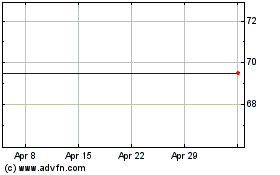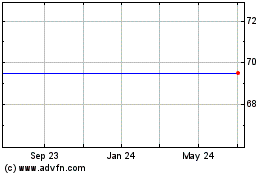Ball Aerospace Completes OMPS Integration for NPP
February 25 2009 - 9:00AM
PR Newswire (US)
BOULDER, Colo., Feb. 25 /PRNewswire-FirstCall/ -- Ball Aerospace
& Technologies Corp. has successfully completed integration of
the Ozone Mapping Profiler Suite (OMPS) for the National
Polar-orbiting Operational Environmental Satellite System (NPOESS)
Preparatory Project (NPP). (Photo:
http://www.newscom.com/cgi-bin/prnh/20090225/LA75133) The OMPS
Flight Model 1 instrument was the first developmental instrument
delivered for spacecraft integration, and the third instrument
integrated to the Ball Aerospace-built NPP spacecraft. The Clouds
and the Earth's Radiant Energy System instrument, and the Advanced
Technology Microwave Sounder were integrated in 2008. The fourth
and fifth instruments, the Cross-track Infrared Sounder and the
Visible Infrared Imaging Radiometer Suite, are scheduled for
delivery in 2009. Once all five instruments are delivered, Ball
will begin full systems integration and test to put the system on
its final path to launch, scheduled for 2010. OMPS is designed to
provide higher fidelity monitoring of ozone from space. OMPS is
comprised of two sensors, a nadir sensor and limb sensor.
Measurements from the nadir sensor are used to generate total
column ozone measurements, while measurements from the limb sensor
generate ozone profiles of the along-track limb scattered solar
radiance. "Developmental instruments are always a challenge which
made it all the more rewarding that our program team was able to
successfully deliver OMPS," said Cary Ludtke, vice president and
general manager for Ball's civil and operational space business
unit. "We anticipate additional significant milestones for NPP in
2009." NPOESS is the nation's next generation low-Earth orbiting
operational environmental system for civilian and military
applications. NPP is a joint effort between the NPOESS Integrated
Program Office and NASA. Ball Aerospace is part of the NPOESS team
led by prime contractor Northrop Grumman Corp. Ball Aerospace &
Technologies Corp. supports critical missions of important national
agencies such as the Department of Defense, NASA, NOAA and other
U.S. government and commercial entities. The company develops and
manufactures spacecraft, advanced instruments and sensors,
components, data exploitation systems and RF solutions for
strategic, tactical and scientific applications. Since 1956, Ball
Aerospace has been responsible for numerous technological and
scientific 'firsts' and is a technology innovator in aerospace.
Ball Corporation (NYSE:BLL) is a supplier of high-quality metal and
plastic packaging products for beverage, food and household
products customers, and of aerospace and other technologies and
services, primarily for the U.S. government. Ball Corporation and
its subsidiaries employ more than 14,500 people worldwide and
reported 2008 sales of more than $7.5 billion. Forward-Looking
Statements This release contains "forward-looking" statements
concerning future events and financial performance. Words such as
"expects," "anticipates," "estimates" and similar expressions are
intended to identify forward-looking statements. Such statements
are subject to risks and uncertainties which could cause actual
results to differ materially from those expressed or implied. The
company undertakes no obligation to publicly update or revise any
forward-looking statements, whether as a result of new information,
future events or otherwise. Key risks and uncertainties are
summarized in filings with the Securities and Exchange Commission,
including Exhibit 99.2 in our Form 10-K, which are available at our
Web site and at http://www.sec.gov/. Factors that might affect our
packaging segments include fluctuation in product demand and
preferences; availability and cost of raw materials; competitive
packaging availability, pricing and substitution; changes in
climate and weather; crop yields; competitive activity; failure to
achieve anticipated productivity improvements or production cost
reductions, including our beverage can end project; mandatory
deposit or other restrictive packaging laws; changes in major
customer or supplier contracts or loss of a major customer or
supplier; and changes in foreign exchange rates, tax rates and
activities of foreign subsidiaries. Factors that might affect our
aerospace segment include: funding, authorization, availability and
returns of government and commercial contracts; and delays,
extensions and technical uncertainties affecting segment contracts.
Factors that might affect the company as a whole include those
listed plus: accounting changes; changes in senior management; the
current global credit squeeze and its effects on liquidity, credit
risk, asset values and the economy; successful or unsuccessful
acquisitions, joint ventures or divestitures; integration of
recently acquired businesses; regulatory action or laws including
tax, environmental, health and workplace safety, including in
respect of chemicals or substances used in raw materials or in the
manufacturing process; governmental investigations; technological
developments and innovations; goodwill impairment; antitrust,
patent and other litigation; strikes; labor cost changes; rates of
return projected and earned on assets of the company's defined
benefit retirement plans; pension changes; reduced cash flow;
interest rates affecting our debt; and changes to unaudited results
due to statutory audits or other effects.
http://www.newscom.com/cgi-bin/prnh/20090225/LA75133
http://photoarchive.ap.org/ DATASOURCE: Ball Aerospace &
Technologies Corp. CONTACT: Roz Brown of Ball Aerospace &
Technologies Corp., +1-303-533-6059,
Copyright
Ball (NYSE:BLL)
Historical Stock Chart
From May 2024 to Jun 2024

Ball (NYSE:BLL)
Historical Stock Chart
From Jun 2023 to Jun 2024
